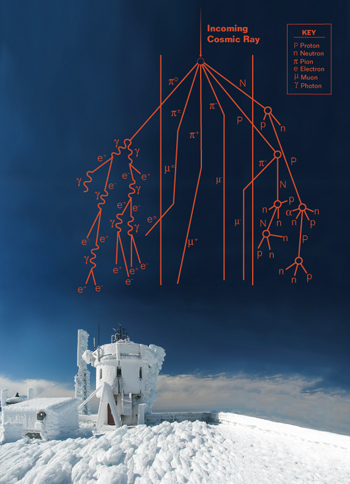Spring 2014
Space Science
THE NETWORK of neutron monitors that have dotted the globe since the 1950s, including those operated by UNH on the Durham campus and atop Mount Washington, remains the most advanced method for ground-based measurements of the cosmic ray flux on Earth.
And, in principal, this array of simple, robust devices is like having one behemoth instrument recording the end result of these near-light-speed galactic particles that penetrate Earth's thick atmosphere, interact with air molecules, and eventually register an equally energetic signal on the ground.
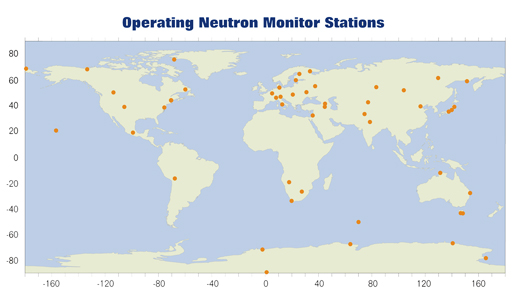 |
|
| The global network of neutron monitors. Illustration: K.Donahue, UNH-EOS. |
But, in fact, because the data have been collected in a variety of different formats over a long period of time, it's less than easy for a scientist to compare data from a cosmic ray event that was, for example, recorded in Moscow with that recorded on Mount Washington—a key comparison to make in understanding the origin and intensity of the cosmic rays and the role our sun plays in their production and transport.
 |
|
| James Ryan. Photo: Kristi Donahue, UNH-EOS. |
"It's overstating the problem," says Space Science Center astrophysicist James Ryan, "but the network has been a bit like a scientific Tower of Babel because the data are not standardized enough to allow for efficient, timely exchange of information and thorough analysis."
Ryan adds that this lack of standardization is compounded by the fact that, more than half a century since these neutron monitors started operating around the globe, with computers and the Internet now allowing nearly instantaneous global access "you should be able to find out what's going on at one station compared to another when these energetic events are occurring."
If, in other words, neutron monitors register a rise in cosmic ray rates due to solar activity, scientists would like to know what's happening simultaneously in Canada, Delaware, Mexico, Siberia, etc. and compare the signals. Located around the globe, the stations observe many small, differing, short-term changes in the cosmic ray intensity—observations that are not accessible to detectors in space.
Ryan asserts that having this global, ground-based network is crucial because, otherwise, scientists are left with the equivalent of "looking through a telescope at an art exhibit," seeing a tiny portion of the bigger picture with no broader, more meaningful context. The network opens up the larger view.
"The network provides a complete picture of an expansive, complicated, and dynamic phenomenon in its entirety—the release of energy from the sun and how that energy is manifested in the form of particle signals, gamma-ray signals, x-rays." Ryan says.
He adds, "When you produce all these particles and want to understand how they behave in this complicated environment that takes place over enormous distances filling up enormous volumes—our sun's entire heliosphere—you've got to get that whole, global picture for it to mean anything, which is important, among other things, for our abilities to better understand and predict space weather conditions."
The cosmic "rays" detected by neutron monitors are in fact high-energy subatomic particles, mostly protons, that collide with air molecules in Earth's upper atmosphere. The collision produces high-energy secondary particles, which then interact with other air molecules creating a cascade of energetic particles through the atmosphere, including neutrons.
Once the neutrons reach the surface of a neutron monitor, the particles pass through a heavy metal inside the device and are then detected by a gas detector tube. Only the highest-energy particles ever reach the ground to be detected by neutron monitors due to Earth's atmosphere and magnetic field, or magnetosphere.
"The neutron intensity at the ground is an excellent surrogate for the proton intensity at the top of the atmosphere," says Ryan.
From babel to robust database
In an effort to bring some order to the network of confusion, the European Union's Framework Programme for Research and Technological Development was brought to bear in the creation of a worldwide Neutron Monitor Database, NMDB for short. The development program is one of the EU's main instruments for supporting collaborative research and development and innovations in science, engineering, and technology. The global database has been under development since 2008.
As part of this, Ryan recently enlisted undergraduate student help in taking more than half a century's worth of UNH neutron monitor data and putting it into a standardized format for inclusion in the NMDB. And at the end of March 2014, the director of the NMDB, Christian Steigies of the Christian-Albrechts-Universität zu Kiel Institute of Experimental and Applied Physics in Germany, visited UNH for the second time to help sort out some bugs in the process and move things along.
As Ryan notes, after decades of using different formats and procedures developed by different people, "standardizing the data requires more than average attention." The NMDB aims to consolidate, organize, and make uniform the neutron monitor data around world, which up till now, he adds, "has all been homegrown, roll-your-own type of operations."
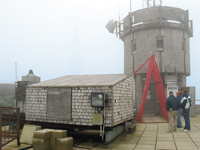 |
|
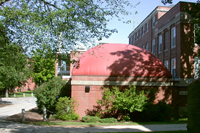 |
|
| Mt. Washington Observatory neutron monitor (top), and DeMeritt Hall neutron monitor. Photos: Kristi Donahue, UNH-EOS. |
"The whole process has been slow and exasperating, and this is data that people are reasonably willing and able to provide. The difficulty of using the neutron monitor data is totally artificial and has real technical solutions, which is what we're currently trying to do. There's no intrinsic reason for it to be so awkward and slow to use these data for research," says Ryan.
UNH currently operates two functional neutron monitors—one in Durham that used to be housed in the basement of DeMeritt Hall and now resides on the outskirts of the campus, and one in Leadville, Colorado.
The Mount Washington neutron monitor is currently idle but was operational from 1955 to 2006 and the university is custodian of historical data from that monitor as well as one in Climax, Colorado (operational from 1951 to 2006), and Haleakala, Hawaii (operational from 1991 to 2006). Currently none of the data from any of these monitors has been contributed to the database.
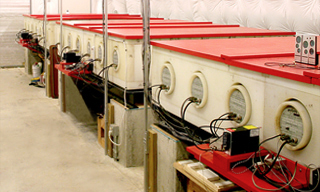 |
||
| Above, the bank of detectors is part of the Durham, N.H., neutron monitor, housed on the edge of campus.
At right, a closeup of one of the detectors. Photos: John Macri, UNH-EOS.. |
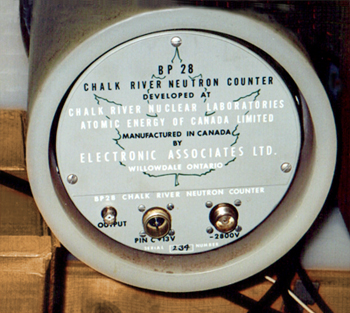 |
|
Last year, senior physics major Leslie Lamarche (now at the University of Alaska Fairbanks) started the process of taking the historical neutron monitor data from Mt. Washington and Durham and standardizing the format for the Neutron Monitor Database, which is providing one common global database for this first time.
The process can be likened to making sausage. A little software engine or algorithm written by Lamarche (the meat grinder in this analogy) takes the data, turns the crank and a jumbled, unpalatable product is transformed into ready-to-eat sausage. The content hasn't changed, it's simply in a new package that can be readily digested by anyone around the world.
The original jumble is due in part to the various formats that have recorded the neutron monitor data over the course of 60-odd years. In the early days data were recorded on paper tape with punched holes, which progressed to little audiocassettes and dial-up data files to today's real-time format.
Notes Ryan, "Over the decades we've used four data formats, and that's enough to drive anybody bonkers in terms of ease of use."
And what does this new easy-to-use data provide? Some of the most revealing cosmic ray events are historical ones that haven't been fully exploited because of the Tower of Babel problem; it was simply too difficult for researchers to try and pull together all the data that might be useful in making a comparative analysis.
"The database will grease the wheels for scientists. It will be much easier now to be able to go back and analyze some older event with some new perspective, to shed some new light on it," says Ryan. "For example, researchers in Moscow might dig up old data and look at what was happening in North America at the same time, and our UNH data will be there for them."
